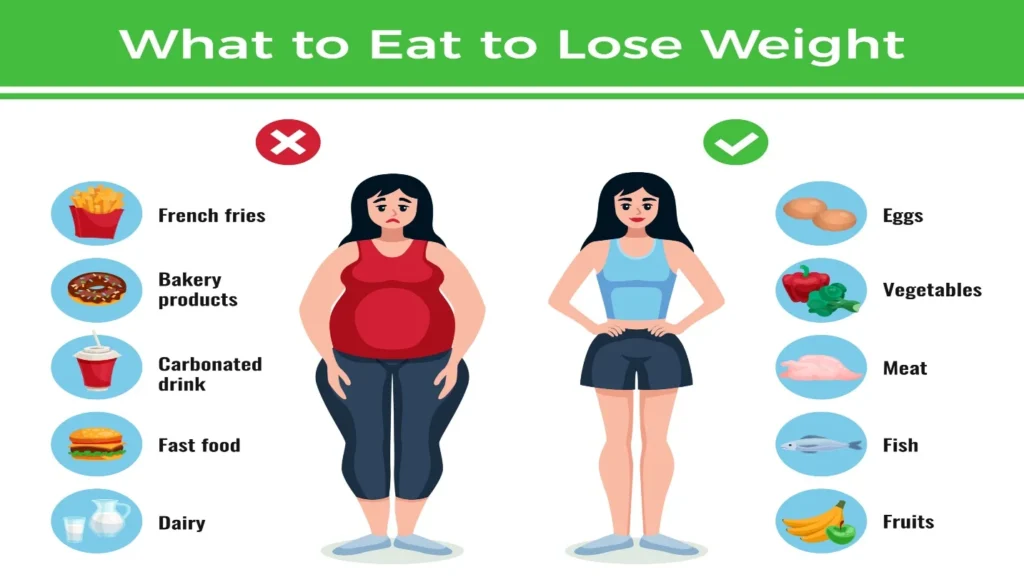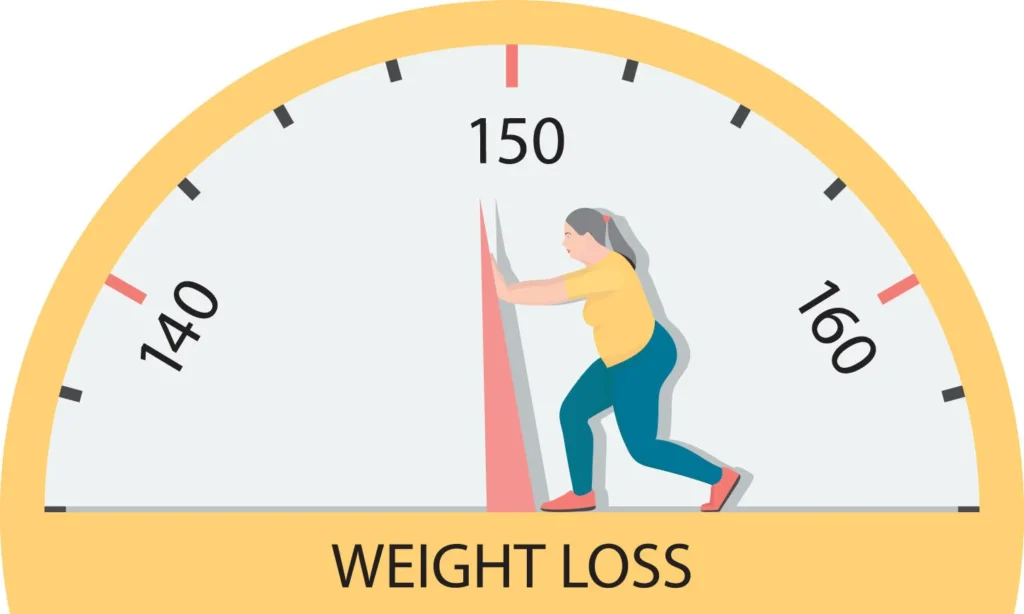10 successful tips for losing weight fast

• Maintaining weight loss involves a commitment to a healthful lifestyle, from which there is no “vacation.” Although people should feel free to enjoy a special meal out, a birthday celebration, or a joyful holiday feast without feeling guilty, they should try not to stray too far from the path of healthful eating
and frequent physical activity.
• Those who do may find that they lose focus. Gaining back lost weight is easier than losing it.
• Achieving and maintaining weight loss is possible when people adopt lifestyle changes in the long term.
• Regardless of any specific methods that help a person lose weight, individuals who are conscious of how and what they eat and engage in daily physical activity or regular exercise will be successful both in losing and keeping off excess weight.
1. Eat colorful, varied and nutritionally dense foods

The following foods are healthful and often rich in nutrients:
• fresh fruits and vegetables
• whole grains, such as brown rice and oatmeal
• seeds
• fish
• nuts
• legumes
Foods to avoid eating include:
• foods with added oils, butter, and sugar
• bagels
• fatty red or processed meats
• white bread
• baked goods
• processed foods
In some cases, removing certain foods from the diet might cause a person to become deficient in some necessary vitamins and minerals. A nutritionist, dietitian, or another healthcare professional can advise a person how to get enough nutrients while they are following a weight loss program.
2. Have a food and weight diary for record

Self-monitoring is a critical factor in successfully losing weight. People can use a paper diary, mobile app, or dedicated website to record every item of food that they consume each day. They can also measure their progress by recording their weight on a weekly basis. Those who can track their success in small increments and identify physical changes are much more likely to stick to a weight loss regimen. People can also keep track of their body mass index (BMI) using a BMI calculator.
3. Do regular physical activity and exercise

Regular exercise is vital for both physical and mental health. Increasing the frequency of physical activity in a disciplined and purposeful way is often crucial for successful weight loss. One hour of moderate-intensity activity per day, such as brisk walking, is ideal. If one hour per day is not possible, the Mayo Clinic suggests that a person should aim for a minimum of 150 minutes per week. People who are not usually physically active should slowly increase the amount of exercise that they do and gradually increase its intensity. This approach is the most sustainable way to ensure that regular exercise becomes a part of their lifestyle.
In the same way that recording meals can psychologically help with weight loss, people may also benefit from keeping track of their physical activity. Many free mobile apps are available that track a person’s calorie balance after they log their food intake and exercise.
If the thought of a full workout seems intimidating to someone who is new to exercise, they can begin by doing the following activities to increase their exercise levels:
• playing outdoor games
• raking leaves
• walking a dog
• gardening
• dancing
• taking the stairs
• parking farther away from a building entrance
4. Measure servings and control portions of your diet

Eating too much of any food, even low-calorie vegetables, can result in weight gain. Therefore, people should avoid estimating a serving size or eating food directly from the packet. It is better to use measuring cups and serving size guides. Guessing leads to overestimating the likelihood of eating a larger-than necessary portion. The following size comparisons can be useful for monitoring food intake when dining out:
• quarter of a cup is a golf ball
• one-half of a cup is a tennis ball
• 1 cup is a baseball
• 1 ounce (oz.) of nuts is a loose handful
• 1 teaspoon is 1 playing die
• 1 tablespoon is a thumb tip
• 3 oz. of meat is a deck of card
5. Eat mindfully

Many people benefit from mindful eating, which involves being fully aware of why, how, when, where, and what they eat. Making more healthful food choices is a direct outcome of becoming more in tune with the body. People who practice mindful eating also try to eat more slowly and savor their food, concentrating on the taste. Making a meal last for 20 minutes allows the body to register all of the signals for satiety. It is important to focus on being satisfied after a meal rather than full and to bear in mind that many “all natural” or low-fat foods are not necessarily a healthful choice. People can also consider the following questions regarding their meal choice:
• Is it good “value” for the calorie cost?
• Are the ingredients healthful?
• Will it provide satiety?
• If it consists a label, how much fat and sodium does it
contain in actual?
4. Eliminate liquid calories

It is possible to consume hundreds of calories a day by drinking sugar-sweetened soda, tea, juice, or alcohol. These are known as “empty calories” because they provide extra energy content without offering any nutritional benefits. Unless a person is consuming a smoothie to replace a meal, they should aim to stick to water or unsweetened tea and coffee. Adding a splash of fresh lemon or orange to water can provide flavor. Avoid mistaking dehydration for hunger. An individual can often satisfy feelings of hunger between scheduled meal times with a drink of water.
7. Stimulus and cue control

Many social and environmental cues might encourage unnecessary eating. For example, some people are more likely to overeat while watching television. Others have trouble passing a bowl of candy to someone else without taking a piece. By being aware of what may trigger the desire to snack on empty calories, people can think of ways to adjust their routine to limit these
triggers.
8. Plan ahead

Stocking a kitchen with diet-friendly foods and creating structured meal plans will result in more significant weight loss. People looking to lose weight or keep it off should clear their kitchen of processed or junk foods and ensure that they have the ingredients on hand to make simple, healthful meals. Doing this can prevent quick, unplanned, and careless eating. Planning food choices before getting to social events or restaurants might also make the process easier.
9. Seek social support

Embracing the support of loved ones is an integral part of a successful weight loss journey. Some people may wish to invite friends or family members to join them, while others might prefer to use social media to share their progress. Other avenues of support may include:
• employee-assistance programs at work
• a positive social network
• group or individual counseling
• exercise clubs or partners
10. Stay positive

Weight loss is a gradual process, and a person may feel discouraged if the pounds do not drop off at quite the rate that they had anticipated. Some days will be harder than others when sticking to a weight loss or maintenance program. A successful weight-loss program requires the individual to persevere and not give up when self-change seems too difficult. Some people might need to reset their goals, potentially by adjusting the total number of calories they are aiming to eat or changing their exercise patterns. The important thing is to keep a positive outlook and be persistent in working toward overcoming the barriers to successful weight loss.
Losing weight

• Successful weight loss does not require people to follow a specific diet plan, such as Slimming World or Atkins. Instead, they should focus on eating fewer calories and moving more to achieve a negative energy balance.
• Weight loss is primarily dependent on reducing the total intake of calories, not adjusting the proportions of carbohydrate, fat, and protein in the diet.
• A reasonable weight loss goal to start seeing health benefits is a 5–10 percent reduction in body weight over a 6-month time frame.
• Most people can achieve this goal by reducing their total calorie intake to somewhere in the range of 1,000–1,600 calories per day.
• A diet of fewer than 1,000 calories per day will not provide sufficient daily nutrition.
• After 6 months of dieting, the rate of weight loss usually declines, and body weight tends to plateau because people use less energy at a lower body weight. Following a weight maintenance program of healthful eating habits and regular
physical activity is the best way to avoid regaining lost weight.
• People who have a BMI equal to or higher than 30 with no obesity-related health problems may benefit from taking prescription weight-loss medications. These might also be suitable for people with a BMI equal to or higher than 27 with obesity-related diseases.
• However, a person should only use medications to support the above lifestyle modifications. If attempts to lose weight are unsuccessful and a person’s BMI reaches 40 or over, surgicaltherapy is an option


